Lesson 1: Solar Electricity Generation in the US and Global Market
Overview
WAIT!
Did you complete the Course Orientation [1]? Before you begin this course, make sure you have completed the Course Orientation (see the Orientation menu). You'll need to read over this material carefully and then successfully complete a quiz on it in Canvas.
Energy is one of the hot topics today. The industry trend is moving toward switching from traditional fossil fuel sources to renewable sources that are cleaner and becoming more competitive in the global market. If you intend to build a coal plant to generate electricity, you would struggle to find the land, capital funds, and expertise and patience to build it. In contrast, electricity from solar is available at different scales with multiple incentives and simple and fast implementation processes.
Note:
We will begin each lesson with a scenario that will place you in a real-world situation. These scenarios will put you in situations where you have to analyze, evaluate, and make decisions when it comes to designing a solar system. We have made sure that these scenarios cover almost all cases you may encounter in real-world solar roles. To take advantage of them, try to immerse yourself in the environment of each scenario.
Lesson 1 Scenario
You work for an electric utility company that is adding a new department for solar energy. During a general meeting, it as announced that you have been chosen to lead that department. Fortunately, you happened to come across the AE 868 Commercial Solar Electric Systems course as part of the Intercollege Master of Professional Studies in Renewable Energy and Sustainability Systems program portfolio at the Penn State World Campus, where you can learn all about the solar "ins and outs."
Your first assignment with the department is to study the solar energy market and see opportunities for different solar energy conversion systems (SECS) for electricity generation in order to choose the most suitable technology to invest in. Then you will study that specific technology's market sectors to understand where to tap into the solar industry and who are the main players. Furthermore, you can find information on basic terminologies and system types and components to understand what solar systems consist of and what components are needed.
This lesson will take you through a journey (in both time and space domains) to learn what you need in order to grasp main topics in the solar industry so that you can lead the solar department with confidence. Furthermore, you may be interested in starting your own solar business. Lesson 1 is the right place to learn the basics.
Learning Outcomes
At the successful completion of this lesson, students should be able to:
- Recognize main types of SECS and their applications for electricity generation including PV, CPV and STE/CSP.
- Identify PV market indicators and main factors driving the development of the PV technology.
- Categorize solar PV system as residential, non-residential and utility scale grid-tied PV systems and their share in the PV market.
- Discuss PV system configurations (grid-connected, stand-alone, bimodal, and hybrid) and their components and various types of energy sources that can be coupled with PV systems.
- Explain the roles of various segments of the PV industry and how they interact with one another.
What is due for Lesson 1?
Lesson 1 will take us one week to complete. Please refer to the Calendar in Canvas for specific time frames and due dates. Specific directions for the assignments below can be found within this lesson and/or in Canvas.
Complete the following Lesson Assignments:
- Complete the Course Orientation [2]
- Read through the Lesson Content
- Complete the Required Reading Assignments:
- Chapter 1, Photovoltaic Systems by James P. Dunlop (text)
- Look over the Recommended Readings:
- Solar Enegy: Mapping the road ahead (IEA 2019) [3]
- SEAI Research, US Solar Market Insight Report [4] & SEIA solar industry research data [5]
- Major Solar Projects in the United States Operating, Under Construction, or Under Development Updated [6]
- International Renewable Energy Agency (IRENA) Annual Review [7]
- Shared Solar: NREL page [8]
- Download simulations and complete the ungraded exercise
- Participate in the Lesson 1 Discussion
- Take the Lesson 1 Quiz in Canvas
Questions?
If you have lesson specific questions, please feel free to post to the Lesson 1 Questions discussion forum in Canvas. While you are there, feel free to post your own responses if you, too, are able to help a classmate with a question. If you have questions about the overall course or wish to share and discuss any "extra" course related commentary (interesting articles, etc.), please feel free to post to the General Questions and Discussion forum.
Review
Some of the content in AE 868 is directly related to topics that are already discussed in other courses. However, these topics are essential building blocks on what we will cover in AE 868. Many lessons will begin with a list that links out to these relevant topics. Please take the time to review the topics here or where noted throughout the lesson.
- EME 810 (Solar: the Response to Energy Constraints) [9]
- EME 810 (Frameworks for Including SECS) [10]
- EME 810 (The Power Grid System) [11]
- EME 810 (Economic Figures of Merit - LCOE) [12]
- EME 812 (1.1 Solar Energy Conversion - Overview) [13]
- EME 812 (1.3 Utility Scale Power) [14]
- EME 812 (5.1. What are concentrating photovoltaics?) [15]
- EME 812 (5.4. CPV Market overview) [16]
- EME 812 (Lesson 6.2. Main components of the PV systems) [17]
- EME 812 (7.1 Introducing Concentrating Solar Power) [18]
SECS and Solar Electricity Systems
Sun is an abundant source of energy that is capable of supplying sustainable energy to all of humanity. After you have familiarized yourself with the material in the "Review" section of this lesson, you can see that Solar energy can be used for different types of applications that range from a basic solar cooker to photovoltaic technology. A summary of the most common usages of solar energy is shown in Figure 1.1.
Solar Energy Technologies/usages
There are various applications of solar energy conversion systems. The first is seen in conjunction with photovoltaic technology and directly converts solar radiation into electricity. The second converts solar energy into heat for such applications as solar hot water, passive solar heating, solar space heating or cooling, and solar cooking. Finally, there is the conversion of heat into electricity, or solar thermal electricity, which utilizes concentrating solar power (CSP) devices such as reflectors and concentrators.

Since solar energy seems to be a valid option for most of our everyday needs, why don’t we use solar to electrify the entire world?
Although solar energy is abundant, a list of historical factors played a huge role in the development and implementation of solar conversion systems that are not the focus of this class. However, recently there has been exponential growth in research, development, and implementation of different SECS worldwide.
As can be seen from Figure 1.1, Photovoltaic (PV) and Solar Thermal Electricity (STE) are the main technologies that are widely used to generate electricity from the sun and which utilize receivers and concentrators, as discussed earlier in other classes found via the Review page in this course. STE uses Concentrating Solar Power technologies (CSP) to focus direct light and convert it into thermal energy and then finally convert it to a usable Electrical Energy, while Solar Photovoltaic systems (PV) directly convert solar radiation (both direct and indirect) into electricity. Finally, there is a new trend in PV utilizing lenses to concentrate solar radiation for higher efficiency while using more advanced PV technology to convert sunlight into electricity. That technology is referred to as Concentrating Photovoltaic, or CPV for short.
Review
To learn more about the CPV and CSP please refer to "EME 812 (5.1. What are concentrating photovoltaics?) [15] and EME 812 (7.1 Introducing Concentrating Solar Power) [18]." (Note: links are also located on the Review page of this Lesson.)
Let's return to the question, "Is solar energy considered a valid option for electricity generation?"
In order for us to answer that question, we need to take a look at some data gathered by the International Energy Agency (IEA). In their Photovoltaic roadmap and Solar Thermal Electricity roadmap in 2014 (links available under "Required Readings" on the first page of the lesson), IEA discussed the potential for electricity generation from solar energy in large scale. Recently there has been a significant increase in the share of solar electricity installations that contribute to the global electricity grid. Some countries are more progressive and others are trying to follow the lead. For the purpose of this class, we will start with some facts about one of the fast growing and emerging solar markets in the world, which is the US market, and the factors that affect the development of such new technology in the energy market. But why are we saying solar in the U.S. is a growing market?
Observing the added capacity percentage of different energy sources within the period from 2010 to 2023 in the US, we can see that Solar is gaining more of a percentage share (an increase from 4 percent in 2010 to 53 percent in 2023) when compared to traditional fossil fuel sources, such as coal or natural gas, as illustrated in Figure 1.2. The promising news about renewable energy and Solar in particular is that the majority of the recently added electricity comes from renewable resources, including Solar. Recently, most utilities are retiring their coal plants and more are interested in Solar power. As we can tell That said, the next few years will witness more solar installations, and the target expected by the IEA by 2050 can be achieved.
Readers are encouraged to read more about the market insights from the SEIA Research website linked below the figure.
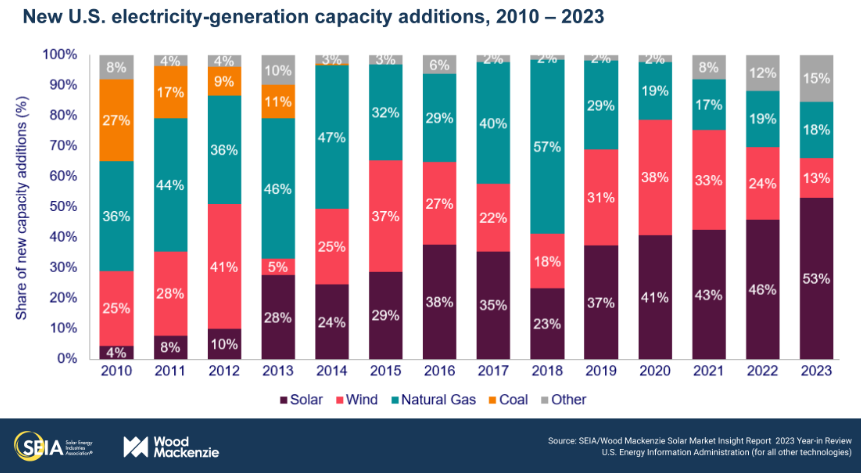
PV Market in the US and Worldwide
Tracking the recorded PV installation, the International Energy Agency (IEA) found that by 2014, the world had added PV with total global capacity that overtook 150 (GW). That is enough to power the entire country of Germany. To understand the bigger, global picture, it is enough to power over 50 developing countries the size of Costa Rica. More recently, the global installed capacity of PV solar exceeded 609 GW according to IEA 2019 solar energy report and the US. Let's move to the United States, according to an SEIA research market insight report in 2022, the total PV installations surpassed 149 GW. According to the "IEA PV roadmap published in 2014," by 2050, PV will provide 16 percent of the world’s global electricity production. We believe all these predictions will happen much sooner.
For most of us, the reasons behind the exponential growth in the PV capacity in the U.S. in the last decade is still not clear. In order for us to understand the reasons behind this fast implementation, we need to track the PV technology prices and investigate how the market is affected by price changes.
If we consider the time period between 1976 and 2035 on a logarithmic scale and draw the PV module prices versus the cumulative manufactured capacity in (GW), we can see that PV module prices have dropped significantly since the early 1970s. As illustrated in Figure 1.3, it can be seen that the price has dropped from close to 100 dollars per watt of handmade technology in the 1970s to less than 50 cents per watt these days. SEIA market insight report has the most up-to-date module and cell prices. Readers are encouraged to visit their website for more information.
Another factor that plays a large role in PV module prices is installation capacity. Observing the relationship between blended average PV price per watt and PV installed capacity in (MW) within the period between 2010 and 2022, we can see (in Figure 1.4) that PV prices are directly influenced by growth in installation capacity so that the installation cost dropped more than 70% since 2010. According to the IEA PV roadmap published in 2014, PV LCOE reached a level below retail electricity in some countries while it is approaching grid parity, and that makes perfect economical sense for investors.
Review
To learn more about LCOE, please refer to "EME 810 (Economic Figures of Merit - LCOE) [12]." (Note: link is also located on the Review page of this Lesson.)

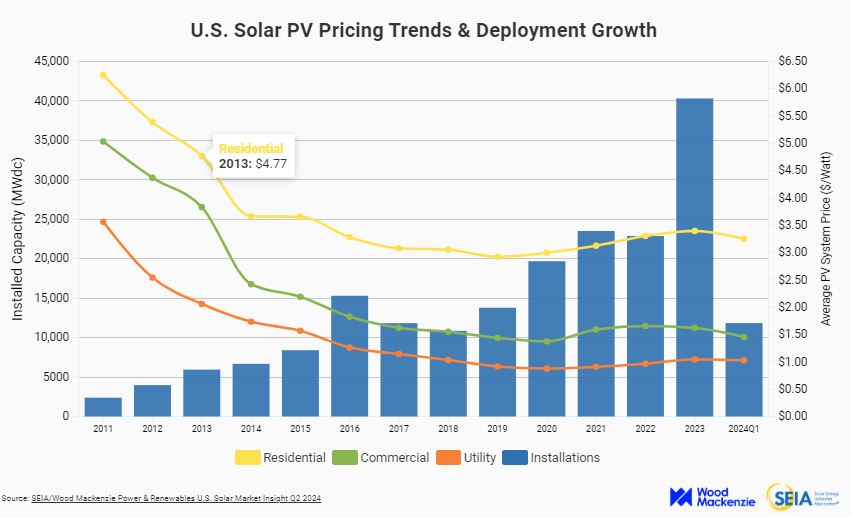
As we can all see, the global inflation and supply chain constraints caused prices volatility especially in the second half of last decade leading to price increase and uncertainty!
n addition to the technology being more affordable, in most countries, the incentives programs have a huge impact on pushing installations forward, which is thoroughly discussed in EME 810's Lesson 9 content -- Energy Portfolio Standards and Government Incentives. To highlight some initiatives as an example, the U.S. Department of Energy's "SunShot Initiative", launched in 2011, supports innovation in manufacturing to help attract new facilities to reduce system cost. In order to make solar electricity cost-competitive, the soft cost needs to reach the targets of the Sunshot Initiative by 2020: USD 0.65/W for residential systems and USD 0.44/W for commercial systems. When all system costs are reduced, SunShot's cost target was put to reach LCOE of $0.06 per kilowatt-hour for utility scale PV, and by the end of 2017, the goal was achieved. The U.S. Department of Energy Solar Energy Technologies Office (SETO) [22] is working toward a levelized cost of $0.02 per kilowatt-hour (kWh) for utility-scale solar photovoltaics, $0.04 per kWh for commercial PV systems, and $0.05 per kWh for residential rooftop PV systems by 2030.
PV Market Segments
After we established that the predominant solar energy technology is mainly Photovoltaic (PV) technology, it is important to understand how PV installations are classified. PV can be classified into three main segments:
- Residential
- Non-residential (including Commercial and Community Shared solar)
- Utility scale
Each of these sectors has its targeted market, but it helps to understand the market share of each sector. If we track annual PV installation capacity for different solar PV sectors from 2014 to 2023, we can see, in Figure 1.5, that the PV utility scale sector has the biggest share in the PV market since 2014 and is second when it comes to the residential PV sector. We can see that the non-residential sector has leveled for several years, while both residential and utility scale installation demands are soaring.
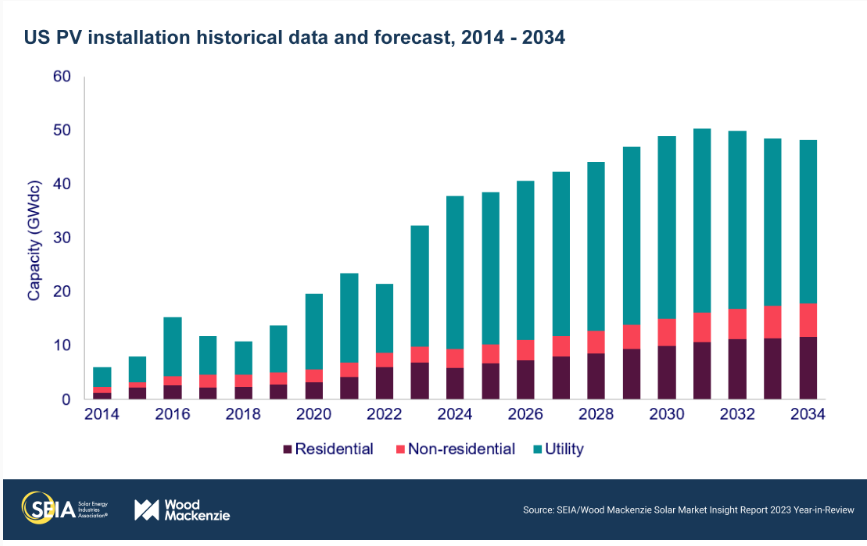
Moving to the PV installations by state, you can see that some northeast states are big on Residential and Commercial (non-utility) PV while California, Texas, and Florida, for example, have mainly Utility scale PV installations. The question remains: why? Is utility scale solar better than residential?
If we compare turnkey-installed PV cost per watt for different market sectors, we can see that utility scale PV installations have the lowest cost. Due to economy of scale, non-residential installations are second lowest. It can also be seen that residential installations have the highest soft costs when compared to the rest of the sectors shown in Figure 1.6. This explains why utility scale PV is more attractive to utilities and investors; we can see that the installed cost for utility scale PV is much lower than both residential and non-residential systems.
Reflection
We can also observe from Figure 1.6 that PV module price is almost the same for all sectors, and that is an important point on which to elaborate since the module is the most important piece in the PV system. As we can see from Figure 1.6, we are talking about module cost, but since all modules are made of cells, the question remains: is there a difference in cost between cells and modules? And which one of them do you look for as a solar designer? Refer to SEAI Reports in 2016 [23], 2017 [24], 2018 [25], 2019 [26], 2020 [27], 2021 [28]- Table 2.5 U.S. prices.
Reflection
Zooming deeper into Figure 1.6, we can break down the cost and compare the additional costs associated with PV residential vs utility scale. Discuss these costs and why residential is more expensive compared to other segments.
Shared Solar (Community Solar)
Aside from the main PV segments we saw at the beginning of this section, where solar power has mostly been available to utilities as utility scale solar plants or to individual home and business owners as rooftop systems for both residential and non-residential sectors, there is a new stream that supports the development of shared solar in communities where homeowners, who are interested in solar but cannot afford it or don’t have space on the roof for PV installation, can share solar with their neighbors and communities to allow everyone to be part of the solar movement.
Shared solar usually consists of a small-scale (few hundreds of kW to few thousands of kW) solar installation that allows multiple individuals to divide their generated power and that allows customers to share ownership of a community-scale PV array, subscribe to the power output of such an array, or both. Of course, there is limitation to subscription systems because electricity markets are regulated in some places.
As for all other PV types, policies and incentive programs are the main market drivers for shared solar.
Market Status (source: NREL page for community solar)
As of December 2023:
- Community solar projects are located in 44 states, plus Washington, D.C.
- 23 states, plus Washington, D.C., have policies that support community solar.
- Community solar projects represent 7,300 megawatts alternating-current (MW-AC) of total installed capacity.
- About 75% of the total market is concentrated in the top four states: Florida (2,083 MW-AC), New York (1,570 MW-AC), Massachusetts (1,005 MW-AC), and Minnesota (875 MW-AC).
Recommended Reading
One of the biggest contributors to the four non-residential solar sectors is the rapid rise of community solar installations. This has boosted the non-residential segment in 2016 and 2017, illustrated by increasing numbers of both off-site and rooftop corporate such as Walmart, Apple, Target, and Amazon.
For more information about shared solar, please refer to the following recommending readings:
- NREL estimate: technical potential for community solar in the United States [30]
- NREL Page for Community solar [8]
- NREL report on “Shared Solar: Current Landscape, Market Potential, and the Impact of Federal Securities Regulation" [31]
- Sunshot report on “A Guide to Community Shared Solar: Utility, Private, and Nonprofit Project Development” [32]
PV System Types and Components
So after this brief introduction about PV technology and application, it is about time to dig deeper into the components that form this PV system and learn more about the types of systems that can serve various applications.
We can easily observe that not all PV systems are alike in terms of system components, size, and type of application. For example, solar water pumping for rural application, where there is no access to an electricity grid, utilizes components that are slightly different from rooftop solar systems for residential application, where a grid already exists.
So what are these main types and components that form the PV system?
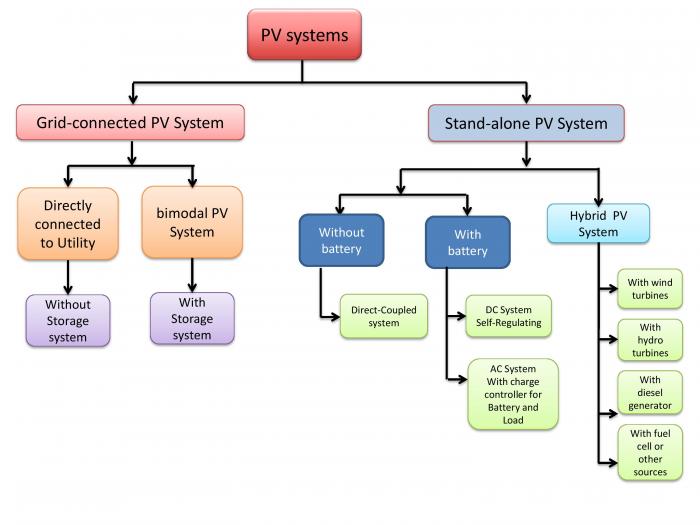
In Figure1. 7 we can see different types of PV configurations that work for both Grid-connected and Stand-alone applications. We can see that the main difference between these two main types is utility grid availability.
Stand-alone PV systems:
All stand-alone (AKA off-grid) systems work in general without the utility grid, as shown in Figure 1.8. It can be seen that we expect a perfect match between the supply and demand, or in other words between PV system size and load requirement. When this match is done perfectly for a single load, the PV system in this case can be called a "Direct-Coupled PV System," and very minimal components are needed without the need for storage systems.
Another type of stand-alone requires a storage system to allow excess energy to be stored when it is not needed by the load and can later be drawn when the sun is not available. This type can be connected directly to DC loads or to AC loads through an additional power conditioning component, or “Inverter,” as we will learn later.
The other common type of stand-alone system is the "Hybrid PV System," as illustrated in Figure 1.9, which uses other energy sources in parallel to the PV array to supply loads. These energy sources can be Wind Turbines, Hydro Turbines, Diesel Generators, or Fuel cells. Hybrid PV Systems can also use Batteries for energy storage.
Grid-Connected system:
This type of configuration is the most common type for applications where clients want to save energy on their utility bills and while the utility grid exists for use when the PV array is not generating any energy. The PV array can be directly coupled to the grid without any storage system and is called “Utility-Interactive PV System or Grid-Tied PV System,” as illustrated in Figure 1.10. Alternatively, it can store excess energy into battery banks for later use, and in this case, it is called a “Bimodal PV System or Battery Backup PV System,” as shown in Figure 1.11.
The following short video walks us through the basics of PV and how it works and shows an example of a grid-connected PV system and the components needed.
Video: How Solar Works (0:58)
Another example of a 100 percent off-grid system installed on an isolated island is illustrated in the following video.
Video: How Tokelau Switched to Solar Energy (4:21)



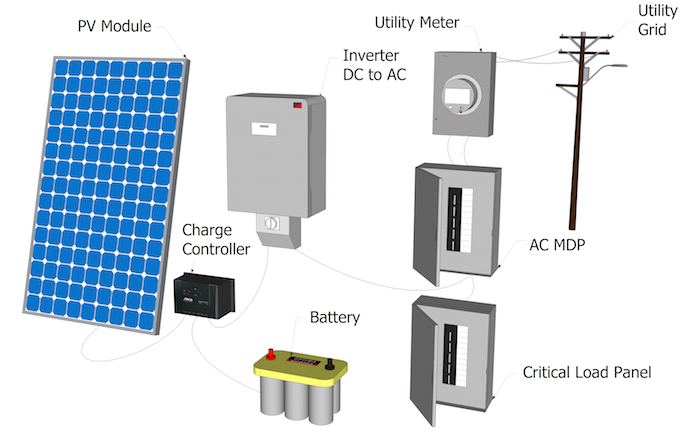
In order for each of the PV system types we discussed in this section to function and deliver usable energy to clients, a number of components are needed to allow energy to be generated, conditioned, stored, and transferred to end users. So what are these components, according to the classification: generation, storage, and conditioning?
Generation:
The main and only component in the PV system that converts solar radiation into electricity is the "Cell" or "Module." We will learn more about that in Lesson 2.
Storage:
Not all energy the PV system generates is used right away, especially when we talk about off-grid systems. So in order for us to maximize the usage of the system, we need some devices to store the energy for later uses, and that is easily done using "Storage devices such as Batteries." We will explain more in Lesson 3.
Conditioning:
Solar PV generates DC electricity, which is not the common form to be used for home appliances and the utility grid in general, which usually uses AC electricity. So in order for us to be able to connect the PV system to the grid we need to change the DC to AC, and that is done using a power conditioning units AKA "inverter." We will discuss this in more detail in Lesson 4.
Review:
General PV system components are extensively discussed in previous classes. You can refer to "EME 812 (Lesson 6.2. Main components of the PV systems) [17]" to review or learn about main components used for PV systems and their functions. (Note: link is also located on the Review page of this Lesson.)
PV Industry Sectors
In order for the PV system to be brought to the client as a final product, dozens of PV industry sectors should work together to achieve this goal. The PV industry is composed of several levels of businesses and organizations. The first level involves manufacturers that usually donors deal directly with clients, but they make the main parts of the PV system, such as Modules, Inverters, Batteries, Balance of Systems. The second level is the medium between the client and the manufacturer, which is referred to as an integrator. The integrator offers services such as engineering design, permitting requirements preparations, installations, monitoring, and operation and maintenance (O&M). Integrators work closely with architects, builders, contractors, and utilities to meet all standards, codes, and regulations. The third level is the installers, who can be either independent entities such as electrical contractors who specialize in PV installations or can also be directly hired by the integrators. Installers are the most visible members of the PV industry, as they are the ones who ensure safe and quality installations.
Finally, there are numerous not-for-profit organizations that advocate their mission to serve and promote the PV industry, such as research institutes, marketers, installer training institutes, and standards development.
With greater market share comes demand for a qualified workforce to help achieve goals, and therefore the U.S. solar job market has soared in the past few years and currently there are around 260,000 people who are qualified or are in training as solar professionals (SEIA press).
According to the International Renewable Energy Agency (IRENA) Annual Review 2023 [shown below and as Figure 1.12 in the recommended reading for this lesson], by the end of year 2023, there were 13.7 million workers in the field of renewable energy worldwide. The PV industry in on the top of the list with the highest number of employees, accounting for nearly 4.9 million workers worldwide who are involved in PV solar-related jobs. On the same list, the CSP workers were only around 80,000 workes worldwide. This proves the fact that solar PV is the still the predominant renewable energy technology, and the need for more qualified practitioner is strongly needed.
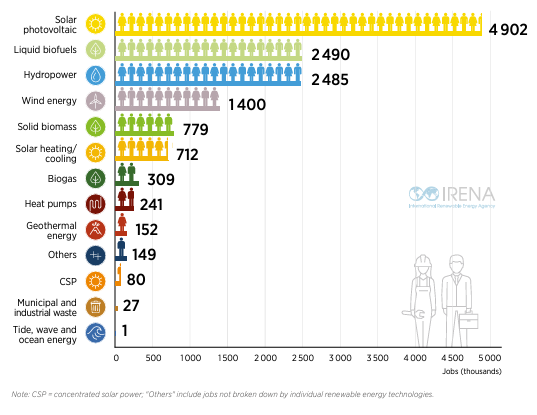
Simulation Exercise
In Lesson 2 we will use simulation software. This exercise requires you to download NREL's System Advisor Model (SAM) [34] and the NREL PVWatt tool [35] for use in the next lesson. This Exercise is ungraded, but it is essential for you to become familiar with these tools to better follow along with the class topics and Lesson Activities.
| Activity | Details |
|---|---|
| Assignment |
Part I: Download SAM
Part II: PVWattTo access PVWatt, you have two options:
Part III: Try Out SAM and PVWatt in a Simulation ExerciseImagine you have a client located in State College, PA. The client wants to install 10 kW using PV technology. You have to come up with the estimated annual, monthly, and daily energy production.
Deliverable: Gather your Result TablesTake a screenshot (including the table) of the SAM result and the PVWatt result. Copy the screenshots into a Word document. Please use the following naming convention: Last Name_First Name L1 Simulation Exercise.docx. Follow the directions below for submission. |
| Submission Instructions |
|
Lesson 1 Discussion
| Activity | Details |
|---|---|
| Assignment | Post original entry: You want to start a solar PV company, so you are looking into different market sectors. You have the following options:
Post comments: Respond to two different opinions of others' posts. (For example, if you choose Option 1, you need to respond to one post for Option 2 and another post for Option 3 or 4.) |
| Requirements, Submission Instructions, and Grading | For more detailed instructions about the discussion component of this course, including how you will be graded, please visit the Discussion Activity [37] page. |
Summary and Final Tasks
Let's go back to our scenario from the beginning of this lesson. You go to the next general meeting for the new solar department lead position. Now that you are loaded with the right information about the solar market, you can easily suggest investing in the PV technology. Furthermore, you realize that depending on the market segment and the size of the utility company you work for, you may suggest considering Utility scale PV systems for large electricity generation. In addition, you are now fully equipped with knowledge and can suggest the industry sector your company can represent within the solar industry.
Even if you decide to start a small solar business, you may consider Residential or Non-residential PV installations or both. Having a design and installation team can help you tap into the right solar industry sector you wish to be part of.
The next lesson will introduce the building block to any PV system, which is the PV "module." We will cover a variety of topics from basic characteristics to factors that affect the performance of PV modules, and finally, the required tests and standards for approved PV module installations.
Reminder - Complete all of the Lesson Requirements!
You have reached the end of this lesson. Before you move to the next lesson, double-check the list on the first page of the lesson to make sure you have completed all of the requirements listed there.
